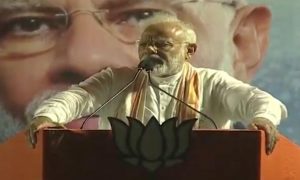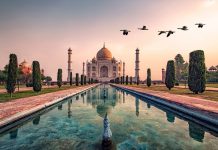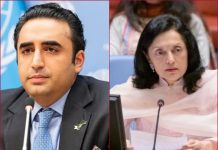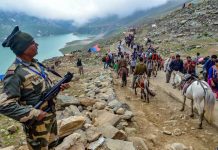
As the political discourse has gone to its lowest ebb, the battle for Race Course has reached its climax with the sixth round of polling. The seven phase long poll saw changing narratives of BJP’s star campaigner Prime Minister Narendra Modi to suit his changing political needs. The people witnessed his arrogant poll strategy firing all types of salvos at his rival political leaders across demographical arena.
At the end of the day, the message emerges with a loud and clear indication that he is losing badly and will not be able to regain the overwhelming mandate of 2014. Poll plank of Hindu Nationalism, Pakistan, national security and surgical strikes could not cut much ice with cemented caste dominance on the grounds of Hindi heartland’s voters. Fragrance of people’s hopes and aspirations evaporated in ocean of despair this time as Modi led a very negative campaign with misplaced priorities that badly shattered ambitious plan of owning majority of his own.
Political observers see no gains for BJP in border states like Jammu & Kashmir, Punjab, Rajasthan, Himachal Pradesh and Gujarat but significant loss as compare to 2014 Lok Sabha as it had saturated with hundred percent seats baring Punjab and J&K. The graph is bound to go down despite invoking security threats from neighbourhood using National Army and Balakot surgical strikes for electoral benefit. No doubts such emotive issues have shown some impact on selective pockets but BJP cannot secure more than 2014. Meanwhile, it had lost Punjab and Rajasthan assembly elections that could also be playing negatively for Modi. Gujarat assembly elections showed recovery signs for the congress party as it lost many seats with very thin margin. Therefore, advantage 2014 was no longer available to ruling BJP.
This perception got momentum following fair and pragmatic assessment by National General Secretary of BJP Ram Madhav that BJP is just short of a clear majority in the 543-seat parliament but with allies, it could comfortably form the next government. “The party will make up expected losses in the north Indian states it swept in 2014 with new gains from remote northeast, as well as in the eastern states of West Bengal and Odisha,” Madhav added. His assessment is far below what other party leaders including finance minister Arun Jaitley and party president Amit Shah have publicly claimed.
Despite optimism of recovering reversals from other corners, many political analysts disagree with the perception and feel that BJP would suffer biggest shock in the states like Odisha, West Bengal and Assam where it is pinning its hopes. In Odisha BJP closely contested against Biju Janata Dal (BJD). On question of BJD post poll alliance with BJP they expressed their reservations and said, “Do you think that Naveen Patnaik has no political sense? In fact, he would emerge only after a close fight with BJP. He may look for another strong alternative.”
West Bengal is going through difficult and violent phase of electioneering where supporters of Trinamool Congress (TMC) and BJP are on the path of head on collision and blood bath. The BJP is making its all-out efforts to recover its losses of Hindi heartland from new states but it suffers the same problems of organisational structure that Congress faces in Uttar Pradesh and Bihar.
TMC chief minister Mamata Banerjee had shown her might in assembly elections in 2016 securing 211 seats out of 294 with 44.9 percent vote share of popular mandate. BJP won just 3 seats with a vote share of just 10.2 percent. Congress party got 44 seats with 12.3 percent vote share. Mamata had adopted anti-Modi stand and both the leaders have locked in street-fight attacking each other with no holds barred. Mamata has emerged on national scene against Narendra Modi and not openly aligned with any political combination.
The pre-poll alliances with political parties matter most in staking claim to form government. The United Progressive Alliance (UPA) led by congress party has already entered into pre-poll alliance with DMK in Tamil Nadu, UDF (Communist parties with allies) in Kerala, NCP in Maharashtra, RJD in Bihar and JMM in Jharkhand. Congress has no alliance in Uttar Pradesh with SP-BSP but its president Rahul Gandhi has clarified that where his candidates are not strong it fielded candidates with potential strength to harm BJP prospects. However, SP Chief Akhilesh Yadav says, “Only results will tell how much support it got this way.” Congress has no alliances in Madhya Pradesh, Chhatisgarh and Rajasthan.
National Democratic Alliance (NDA) led by BJP has already had pre-poll alliance with regional players like Shiromani Akali Dal (SAD) in Punjab, Apna Dal in Uttar Pradesh, Shiv Sena in Maharashtra, Janata Dal (U) in Bihar and Assam Gana Parishad in Assam.
Responding to the various possibilities that could emerge post elections, and the legality of calling the stronger pre-poll alliance to form the government over a stronger post-poll one, the former finance minister P. Chidambaram said in an interview with a web portal, “Our pre-poll alliances and the BJP’s are known to everybody.” “The pre-poll alliances are very relevant as that is the law of the country as declared by the Supreme Court. So, if we go by the declared alliances, our alliances will be ahead of the BJP’s,” he added. “As per the law, as we have seen in the Goa Assembly elections, even a post-poll alliance has to be taken into account,” he summed up.
The third scenario may take shape after declaration of results on 23rd May, when decisive talks of forging non-BJP, non-Congress Federal Front could be progressed after analysing their collective bargaining strength. The chief minister of Telangana and founder of the Telangana Rashtra Samithi (TRS) Kalvakuntla Chandrashekhar Rao popularly known as KCR is vigorously chased this idea across various regional political parties. In this regard, he met to open dialogue on the issue with Kerala CM Pinarayi Vijayan and Karnataka CM H.D. Kumaraswamy, DMK leader M.K. Stalin, TMC founder and West Bengal chief minister Mamata Banerjee, Odisha chief minister and head of BJD Naveen Patnaik, Uttar Pradesh SP-BSP alliance leaders Akhilesh Yadav and Mayawati. All the leaders are busy weighing their option. Interestingly KCR has not seized his option to go with UPA and exploring ways and means to come closer to UPA. KCR has not showed any inclination to support BJP until now.
Political scene in the Uttar Pradesh is not looking congenial for BJP ever since formation of SP-BSP alliance with Akhilesh Yadav and Mayawati. The fast changing ground reality has changed caste dynamics that upset the well-planned strategy of BJP. BJP secured 73 seats out of 80 in the 2014 Lok Sabha elections but this time it is heading for major reversals demolishing all tall claims of its leaders. Prime Minister Modi left no stone unturned to target the alliance leaders Mayawati and Akhilesh Yadav below the belt but they cemented their understanding on the firm footings with their masses.
The grassroots response had sent shockwaves to BJP leadership because of solidarity shown by its voters who set aside all old acrimony and worked together for defeating BJP nominees. SP Chief Akhilesh Yadav underlined the importance of alliance and emphatically asserted, “No one could get crown without our support.” Mayawati also attacked Modi on his caste affiliations in retaliation as PM leveled allegations of corruption against her in the sale of government owned sugar mills during her regime as chief minister. Yogi government has recently referred the matter for CBI probe. She also observed that Modi has lost the backing of RSS. Its workers are not visible in field to pullout voters.
The elections in UP also noticed abnormal phenomena of BJP and RSS workers who looked indifferent because of their continued neglect as turncoats were more gainfully accommodated with respect those just joined the ruling party for greener political pastures. These factors further jeopardized the prospects of BJP to retain its 2014 tally. Political sources see a major setback for ruling party as it may lose more than 50 seats in U.P and overall 100-110 including loss from other states putting it in an uncomfortable position to form next government with its own strength and might.
The picture is not going to be different for BJP in last leg- seventh phase on 19th May, in remaining 59 Lok Sabha constituencies across Bihar (8), Himanchal Pradesh (4), Jharkhand (3), Punjab (13), Madhya Pradesh (8), Uttar Pradesh (13) West Bengal (9) and Chandigarh (UT). In Uttar Pradesh 13 seats of the eastern part would go to poll where the prestige of Modi and Yogi is on the stake. This belt is most backward and dominated by caste-ridden political equations. The SP-BSP alliance has already demonstrated its devastating impact in the by-election of Gorakhpur, Phulpur and Kairana (UP west) where it won all the three Lok Sabha seats from none other than saffron clad chief minister Yogi Aditynath and his deputy Keshav Mourya. Apparently, this was a receding point of saffron tide from where BJP graph started going down.
The 2019 General election has usher new beginning for congress party. Priyanka Gandhi Vadra has benefited the party to galvanize the eclipsed cadre from oblivion through her aggressive campaigning style and timely jibes over prime minister’s unique remarks given to selective media forums. Coming days will be full action, drama, lobbying and formation of new equations and regional parties would play decisive role to determine the way polity of the country moves on.











